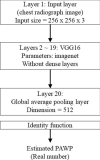Quantitative estimation of pulmonary artery wedge pressure from chest radiographs by a regression convolutional neural network
- PMID: 35220466
- PMCID: PMC9239946
- DOI: 10.1007/s00380-022-02043-w
Quantitative estimation of pulmonary artery wedge pressure from chest radiographs by a regression convolutional neural network
Abstract
Recent studies reported that a convolutional neural network (CNN; a deep learning model) can detect elevated pulmonary artery wedge pressure (PAWP) from chest radiographs, the diagnostic images most commonly used for assessing pulmonary congestion in heart failure. However, no method has been published for quantitatively estimating PAWP from such radiographs. We hypothesized that a regression CNN, an alternative type of deep learning, could be a useful tool for quantitatively estimating PAWP in cardiovascular diseases. We retrospectively enrolled 936 patients with cardiovascular diseases who had undergone right heart catheterization (RHC) and chest radiography and estimated PAWP by constructing a regression CNN based on the VGG16 model. We randomly categorized 80% of the data as training data (training group, n = 748) and 20% as test data (test group, n = 188). Moreover, we tuned the learning rate-one of the model parameters-by 5-hold cross-validation of the training group. Correlations between PAWP measured by RHC [ground truth (GT) PAWP] and PAWP derived from the regression CNN (estimated PAWP) were tested. To visualize how the regression CNN assessed the images, we created a regression activation map (RAM), a visualization technique for regression CNN. Estimated PAWP correlated significantly with GT PAWP in both the training (r = 0.76, P < 0.001) and test group (r = 0.62, P < 0.001). Bland-Altman plots found a mean (SEM) difference between GT and estimated PAWP of - 0.23 (0.16) mm Hg in the training and - 0.05 (0.41) mm Hg in the test group. The RAM showed that our regression CNN model estimated high PAWP by focusing on the cardiomegaly and pulmonary congestion. In the test group, the area under the curve (AUC) for detecting elevated PAWP (≥ 18 mm Hg) produced by the regression CNN model was similar to the AUC of an experienced cardiologist (0.86 vs 0.83, respectively; P = 0.24). This proof-of-concept study shows that regression CNN can quantitatively estimate PAWP from standard chest radiographs in cardiovascular diseases.
Keywords: Artificial intelligence; Deep learning; Diagnostic method; Heart failure.
© 2022. The Author(s).
Conflict of interest statement
None.
Figures




Similar articles
-
Fully Elman Neural Network: A Novel Deep Recurrent Neural Network Optimized by an Improved Harris Hawks Algorithm for Classification of Pulmonary Arterial Wedge Pressure.IEEE Trans Biomed Eng. 2022 May;69(5):1733-1744. doi: 10.1109/TBME.2021.3129459. Epub 2022 Apr 21. IEEE Trans Biomed Eng. 2022. PMID: 34813462
-
Deep Learning for Detection of Elevated Pulmonary Artery Wedge Pressure Using Standard Chest X-Ray.Can J Cardiol. 2021 Aug;37(8):1198-1206. doi: 10.1016/j.cjca.2021.02.007. Epub 2021 Feb 18. Can J Cardiol. 2021. PMID: 33609716
-
A novel echocardiographic method for estimation of pulmonary artery wedge pressure and pulmonary vascular resistance.ESC Heart Fail. 2021 Apr;8(2):1216-1229. doi: 10.1002/ehf2.13183. Epub 2021 Feb 10. ESC Heart Fail. 2021. PMID: 33566429 Free PMC article.
-
Pulmonary Arterial Wedge Pressure at Rest and During Exercise in Healthy Adults: A Systematic Review and Meta-analysis.J Card Fail. 2019 Feb;25(2):114-122. doi: 10.1016/j.cardfail.2018.10.009. Epub 2018 Oct 23. J Card Fail. 2019. PMID: 30366054
-
A Fluid Challenge Test for the Diagnosis of Occult Heart Failure.Chest. 2021 Feb;159(2):791-797. doi: 10.1016/j.chest.2020.08.019. Epub 2020 Aug 14. Chest. 2021. PMID: 32805242 Review.
Cited by
-
Artificial Intelligence in Clinics: Enhancing Cardiology Practice.JMA J. 2025 Jan 15;8(1):131-140. doi: 10.31662/jmaj.2024-0190. Epub 2024 Dec 24. JMA J. 2025. PMID: 39926098 Free PMC article. Review.
-
Chest radiography deep radiomics-enabled aortic arch calcification interpretation across different populations.iScience. 2023 Mar 16;26(4):106429. doi: 10.1016/j.isci.2023.106429. eCollection 2023 Apr 21. iScience. 2023. PMID: 37009230 Free PMC article.
-
Prognostic significance of pulmonary arterial wedge pressure estimated by deep learning in acute heart failure.ESC Heart Fail. 2023 Apr;10(2):1103-1113. doi: 10.1002/ehf2.14282. Epub 2022 Dec 29. ESC Heart Fail. 2023. PMID: 36583242 Free PMC article.
-
A review of evaluation approaches for explainable AI with applications in cardiology.Artif Intell Rev. 2024;57(9):240. doi: 10.1007/s10462-024-10852-w. Epub 2024 Aug 9. Artif Intell Rev. 2024. PMID: 39132011 Free PMC article.
-
Changes in lung fluid levels with variations in the respiratory cycle.Heart Vessels. 2023 May;38(5):749-752. doi: 10.1007/s00380-022-02186-w. Epub 2022 Oct 12. Heart Vessels. 2023. PMID: 36222948
References
-
- Ambrosy AP, Fonarow GC, Butler J, Chioncel O, Greene SJ, Vaduganathan M, Nodari S, Lam CSP, Sato N, Shah AN, Gheorghiade M. The global health and economic burden of hospitalizations for heart failure: lessons learned from hospitalized heart failure registries. J Am Coll Cardiol. 2014;63:1123–1133. doi: 10.1016/j.jacc.2013.11.053. - DOI - PubMed
-
- Stevenson WG, Stevenson LW, Middlekauff HR, Fonarow GC, Hamilton MA, Woo MA, Saxon LA, Natterson PD, Steimle A, Walden JA, Jan HT. Improving survival for patients with advanced heart failure: a study of 737 consecutive patients. J Am Coll Cardiol. 1995;26:1417–1423. doi: 10.1016/0735-1097(95)00341-X. - DOI - PubMed
MeSH terms
LinkOut - more resources
Full Text Sources
Miscellaneous

